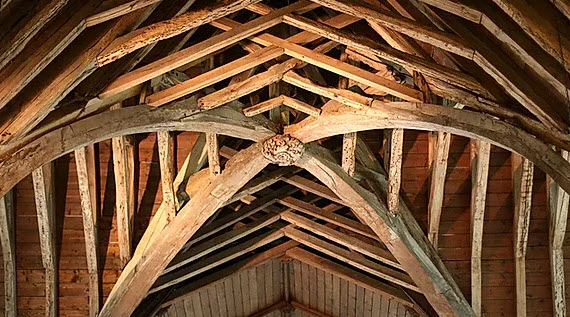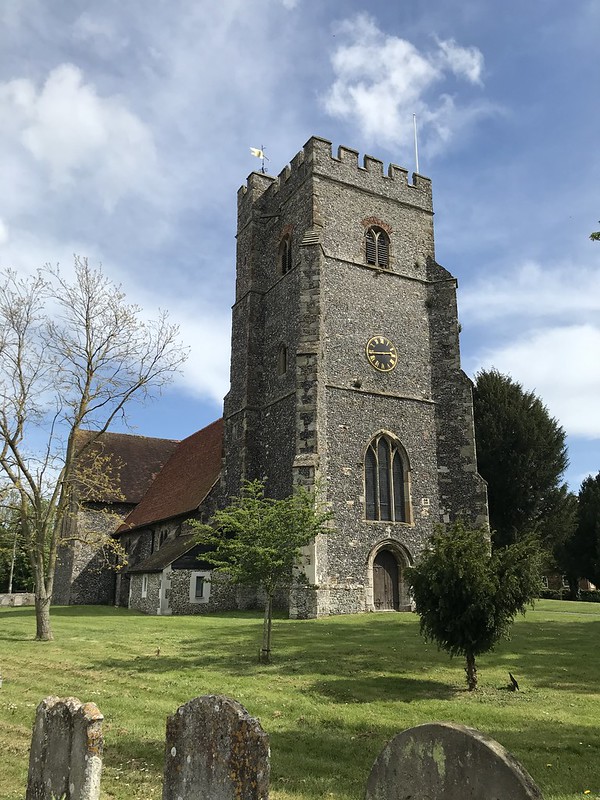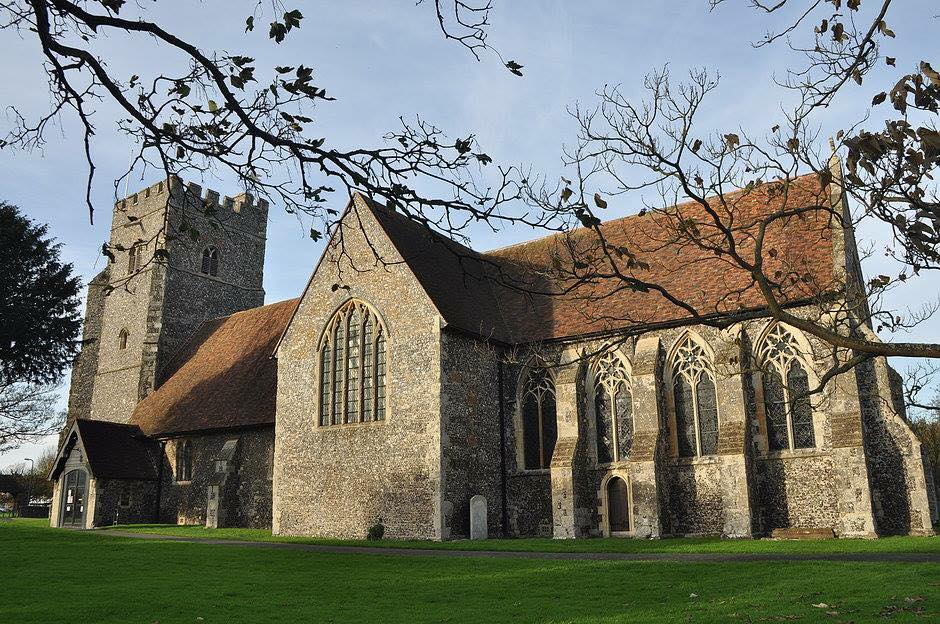The history and heritage of St. Mary's church
We have a rich and varied history at St. Mary's going back between 1285 and circa 1305 with a later tower of the fourteenth century, the church was restored in 1875 by George Edmund Street. The church is designated by English Heritage as a Grade I listed building.
Architecture and fittings
The church is constructed of Kentish knapped flint with ragstone quoins. It is of cruciform design, with nave, transepts, chancel and tower. The church has a number of features of particular note. The nave, transepts and crossing have "a magnificent series of c. 1300 timber rooves with large scissor-trussed rafters." The windows in the chancel are considered amongst the very best examples of Kentish tracery. The stained glass, although "much renewed in 1881 (has) enough glass of c.1294 to guarantee the authenticity of the whole." The brass of the medieval knight, Sir Robert de Septvans, is the one of the oldest in the country and you can more about him here. The church also contains monuments by Rysbrack and Thomas Scheemakers.


SIR ROBERT de SEPTVANS - MEDIEVAL MILITARY FUNERARY BRASS
Sir Robert de Septvans was born c1250. It is highly probable that Sir Robert, a Knight for the Shire of Kent, took part in the 9th Crusade in 1271 under (the then) Prince Edward, later Edward I, who donated 50 marks towards the building of a church at Chartham in 1294.
The name Septvans probably derives from 'Septem Vannis' (seven winnowing fans used to separate the wheat from chaff in the threshing process), a distinctive design which appears to have been the emblem of his family and which also appears on the commemorative brass. The de Septvans' family motto 'Dissipabo inimicos Regis mei ut paleam'. 'The enemies of my King will I disperse like chaff' suggests a connection between the family emblem and the sentiment of their motto.
In 1275 Sir Robert was made Constable of Rochester Castle. Rochester Castle was strategically important as it dominated the Medway estuary and was regarded as an essential part of the defence of South East England. However, this would also have been at a period of managing decline at the castle as, due to the effects of a siege in 1264, much of the castle was burnt out ruins. It had also suffered from many years of pilfering of materials from what remained. As a Knight for the Shire of Kent, Sir Robert's association with the monarch continued. In 1300 he fought with King Edward I at the battle Caerlaverock, on the southern coast of Scotland, and continued northwards with the King's army to fight against the Scots led by William Wallace. At the siege of Caerlaverock Castle he was created a knight banneret by the King for gallantry. In medieval
times this was an honour bestowed by the monarch and meant that a knight could bring a company of his own followers into the field of battle under his own banner. Under English custom the rank of knight banneret could only be conferred by the King on the field of battle. The military rank of knight banneret was higher than that of knight bachelor (who fought under another's banner), but lower than that of an earl or a duke.
In 1302 and 1303 Sir Robert is mentioned as having responsibility for work to control flooding and drainage along the sea coast of Kent and Sussex. The years 1286 to 1288 had seen widespread storm surge related flooding in areas of East Kent, and floods in coastal areas of Sussex became increasingly damaging in the period of 1350 to 1450. The Calendar of Patent Rolls shows Sir Robert de Septvans as one of a Commission de walliis et fossatis', (responsibility for the erection of walls and digging of ditches) in an attempt to put in place flood defences. The flooding was causing the loss of life of both people and livestock and destroying land.
In 1304, with his increasing infirmity, he was relieved of this role and eventually died in 1306. He was buried in St Mary's at Chartham, probably
close to the altar as befitted his rank and achievements. And so St Mary's Church at Chartham became the final resting place for Sir Robert de Septvans, a 13th Century Medieval Knight. His commemorative funerary brass, one of the oldest military funerary brasses in England, was originally situated at the centre of the Chancel but was moved to the North Transept during the Victorian renovation of the church in 1875.
SIR ROBERT de SEPTVANS - CONSERVATION PROJECT
For hundreds of years tucked away in a corner of St Mary's church has lain a very significant and historical artefact. A memorial brass depicting Sir Robert de Septvans, a medieval knight in the reign of Edward I, has lain in the church since the early 14th Century. The highly skilled carved brass shows Sir Robert in medieval combat dress. This amazing piece of history has, however, spent many years hidden, surrounded by mops, buckets ladders and vacuum cleaners as well as a storage rack containing all manner of odds and ends.
The memorial brass can be found in a corner of the North Transept, close to the pulpit. Sir Robert, who lived at Milton Manor died in 1306 and would have been buried in the chancel area of the church, close to the altar and the memorial brass would have been placed close to the burial site. It was moved to its present position during the Victorian Restoration of the church between 1873 and 1875. The Victorian chancel refurbishment, which included the addition of four stained glass panels to the east window, the erection of an altar and the installation of the beautifully carved oak choir stalls and the laying of Victorian Gothic design floor tiles obviously meant that the medieval memorial brass had to be removed from the area to accommodate the new layout.
In 2014 a report was commissioned by the Church Buildings Council to ascertain the condition of the brass and to make recommendations for the future preservation and treatment of this highly significant historical artefact. The report was completed by Rose Lees Hood of Rupert Harris Conservation Ltd of London, but among the papers is a comment about the monumental brass by Sally Badham, an expert in medieval church and churchyard monuments. Among her comments she wrote - 'The military brass at Chartham, Kent is undoubtedly one of the finest and most important brasses surviving in England. Stylistic analysis shows that this brass belongs to a pattern series engraved in a London marbles brass engraving workshop, which has been termed 'the Septvans style' after this iconic brass. The brass is one of five full-length military brasses dating from the first quarter of the fourteenth century which are well-known for their exceptional quality of design and engraving. Despite having spent some 700 years on church floors where they are susceptible to significant footfall, they remain in near perfect condition. The Septvans brass is the only knight shown bare-headed and is arguably the most elegant example with its beautifully drawn drapery folds, elaborately decorated sword scabbard and stylish hair. In addition to to its intrinsic artistic value, this brass is also important for the study of armour. Very little actual armour survives from this period; hence knowledge of the development of armour depends primarily on its depiction in manuscripts and on monuments, brasses showing details especially clearly. The Septvans brass is especially important as it has articulated poleyns (knee defences) and early representation of the 'ringlocket' method of attaching the sword to the scabbard'.
In November 2018, after some four years of discussion, site visits, emails and phone conversations, the Pilgrim Trust, an organisation which gives grants to preserve historically significant historical artefacts,
agreed to fund conservation work for this amazing military funerary brass, probably the last such brass of the reign of Edward I. We are very grateful to the Pilgrim Trust for its financial support of this project.
Last November, Simon Cottle, a conservator from Rupert Harris Conservation Ltd spent three days working on the brass. He was quite surprised at how good the basic condition of the brass was, despite some
rather strange conservation work which had been carried out in the 1970s, which could have proved more damaging than conserving. Simon spent three days lying flat beside the brass working with chemicals on cotton buds to individually remove the green corrosion spots from the brass - a problem caused by bat droppings. As this process brightens the spots which have been treated, he then used other techniques to dull these areas to the same colour as the rest of the brass. The brass was then generally cleaned, waxed and lightly polished. And the result has been exceptional. The detail of the engraving of the knight's armour and clothing is amazingly clear. We are very grateful to Simon for all his work. And we now have material covers to cover the brass to protect it from any further corrosion from the bats.
Finally, the area around the brass has been cleared and carpeted and a small history display about Sir Robert de Septvans has been put in place. So please come along to the church and have a look at this quite
astonishingly well preserved 700 year old monumental brass. Just please put the material cover back after you have finished viewing the brass - to help prevent future bat problems!
Patricia Allen, November 2019